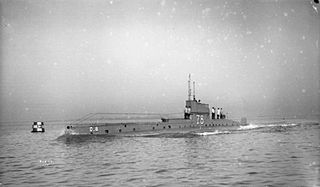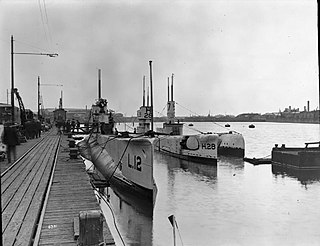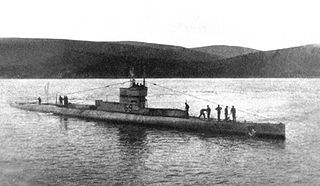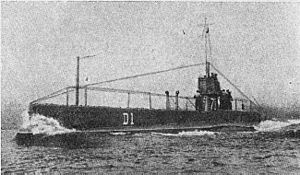HMS R12 was one of 10 R-class submarines built for the Royal Navy during the First World War. The boat was not completed before the end of the war and was sold for scrap in 1923.

HMS D2 was one of eight D-class submarine built for the Royal Navy during the first decade of the 20th century.
HMS D6 was one of eight D-class submarine built for the Royal Navy during the first decade of the 20th century.
HMS D7 was one of eight D-class submarines built for the Royal Navy during the first decade of the 20th century.

HMS D8 was one of eight D-class submarines built for the Royal Navy during the first decade of the 20th century.

HMS L1 was the lead boat of the L-class submarines built for the Royal Navy during World War I.

HMS L4 was a L-class submarine built for the Royal Navy during World War I. The boat survived the war and was sold for scrap in 1934.

HMS L6 was a L-class submarine built for the Royal Navy during World War I. The boat survived the war and was sold for scrap in 1935.

HMS L52 was a late-model L-class submarine built for the Royal Navy during the First World War. The boat was not completed before the end of the war and was sold for scrap in 1935.
HMS L54 was a late-model L-class submarine built for the Royal Navy during the First World War. The boat was not completed before the end of the war and was sold for scrap in 1939.
HMS L56 was a late-model L-class submarine built for the Royal Navy during the First World War. The boat was not completed before the end of the war and was sold for scrap in 1938.
HMS L69 was a late-model L-class submarine built for the Royal Navy during the First World War. The boat was not completed before the end of the war and was sold for scrap in 1939.

HMS L9 was an L-class submarine built for the Royal Navy during World War I. The boat survived the war and was sold for scrap in 1927.

HMS L12 was a L-class submarine built for the Royal Navy during World War I. She was one of five boats in the class to be fitted as a minelayer. The boat survived the war and was sold for scrap in 1932.
HMS L16 was a L-class submarine built for the Royal Navy during World War I. The boat survived the war and was sold for scrap in 1934.
HMS L17 was a L-class submarine built for the Royal Navy during World War I. She was one of five boats in the class to be fitted as a minelayer. The boat survived the war and was sold for scrap in 1934.

HMS L18 was a L-class submarine built for the Royal Navy during World War I. The boat was completed after the war and was sold for scrap in 1936.
HMS L24 was a L-class submarine built for the Royal Navy during World War I. The boat was not completed before the end of the war and was sunk in an accidental collision in 1924.
HMS L25 was a L-class submarine built for the Royal Navy during World War I. She was one of five boats in the class to be fitted as a minelayer. The boat survived the war and was sold for scrap in 1935.

HMS G8 was a G-class submarine of the Royal Navy that saw service during World War I, costing an estimated £125,000.










